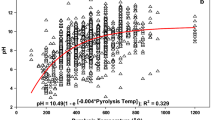Abstract
Rapid determination of biomass composition is critical for the selection of shrub willow varieties with optimized biomass properties for conversion into fuels or chemicals. In order to improve the process for identifying and selecting shrub willow clones with distinct biomass composition, high-resolution thermogravimetric analysis (HR-TGA) was developed as a rapid, low-cost method for analyzing large numbers of willow biomass samples. In order to validate the HR-TGA method, bulk biomass collected from 2-year-old stems of a selected set of 25 shrub willow clones was analyzed using traditional wet chemistry techniques in addition to HR-TGA. The results of the wet chemistry and the HR-TGA method were compared using regression analysis resulting in R-squared values above 0.7 for the three main wood components, cellulose, hemicellulose, and lignin. Bark was removed from duplicate stem samples of the same clones, the proportion of bark was determined, and the debarked wood was used for HR-TGA analysis of composition. While there were significant differences in the proportions of lignin and cellulose in debarked wood compared to bulk biomass, as well as significant differences in bark percentage among clones, there was no correlation between bark percentage and bulk biomass component analysis. This work validates the effectiveness, precision, and accuracy of HR-TGA as a reasonably high-throughput method for biomass composition analysis and selection of shrub willow bioenergy crop varieties.




Similar content being viewed by others
References
Adler A et al (2005) Estimation and relevance of bark proportion in a willow stand. Biomass Bioenergy 29:102–113
Christersson L, Sennerby-Forsse L (1994) The swedish programme for intensive shortrotation forests. Biomass Bioenergy 6:145–149
Hames BR et al (2003) Rapid biomass analysis. Appl Biochem Biotechnol 105:5–16
Jonsson LJ et al (1998) Detoxification of wood hydrolysates with laccase and peroxidase from the white-rot fungus Trametes versicolor. Appl Microbiol Biotechnol 49:691–697
Kelley S et al (2004) Use of near infrared spectroscopy to measure the chemical and mechanical properties of solid wood. Wood Sci Tech 38:257–276
Kiemle DJ et al (2004) Proton NMR methods in the compositional characterization of polysaccharides. In: Gatenholm P, Tenkanen M (eds) ACS Symposium Series 864. American Chemical Society, Washington, DC, pp 122–139
Kopp RF (2000) Genetic improvement of Salix using traditional breeding and AFLP fingerprinting Ph.D. Thesis, State University of New York College of Environmental Science and Forestry
Kopp RF et al (2002) Predicting within-family variability in juvenile height growth of Salix based upon similarity among parental AFLP fingerprints. Theor Appl Genet 105:106–112
Labbe N et al (2005) Ft-IR and pyrolysis-molecular beam mass spectrometry: new tools to investigate wood tissues. Wood Sci Tech 39:61–77
Orfao JJM et al (1999) Pyrolysis kinetics of lignocellulosic materials—three independent reactions model. Fuel 78:349–358
Palmqvist E et al (1996) The effect of water-soluble inhibitors from steam-pretreated willow on enzymatic hydrolysis and ethanol fermentation. Enzyme Microb Technol 19:470–476
Petterson R (1984) The chemical composition of wood. In: Rowell R (ed) The chemistry of solid wood. American Chemical Society, Washington, D.C., pp 57–126
Raveendran K et al (1996) Pyrolysis characteristics of biomass and biomass components. Fuel 75:987–998
Sassner P et al (2006) Bioethanol production based on simultaneous saccharification and fermentation of steam-pretreated Salix at high dry-matter content. Enzyme Microb Technol 39:756–762
Sassner P et al (2008) Techno-economic evaluation of bioethanol production from three different lignocellulosic materials. Biomass Bioenergy 32:422–430
Serapiglia MJ et al (2008) High-resolution thermogravimetric analysis for rapid characterization of biomass composition and selection of shrub willow varieties. Appl Biochem Biotechnol 145:3–11
Shafizadeh F, Chin PPS (1977) Thermal decomposition of wood. In: Goldstein IS (ed) Wood technology: chemical aspects. American Chemical Society Symposium Series 43, pp 57–81
Sjostrom E (1993) Wood chemistry: Fundamentals and applications, 2nd edn. Academic, New York
Skoog DA, et al., eds (1998) Principles of Instrumental Analysis, 5th Ed. Brooks/Cole, United States
Smart LB et al (2005) Genetic improvement of shrub willow (Salix spp.) crops for bioenergy and environmental applications in the United States. Unasylva 221 56:51–55
Stipanovic AJ, et al. (2004) High Resolution Thermogravimetric Analysis (HR-TGA) in the Compositional Characterization of Polysaccharides. In American Chemical Society Symposium on “Novel Analytical Tools in the Characterization of Polysaccharides”, Cellulose and Renewable Materials Division, Philadelphia, PA
TAPPI Standard T 204 om-88 (1988a) Solvent extraction of wood and pulp. In TAPPI Test Methods 1994–1995. TAPPI, Technology Park, Atlanta, GA
TAPPI Standard T 222 om-88 (1988b) Acid-insoluble lignin in wood and pulp. In TAPPI Test Methods 1994–1995. TAPPI, Technology Park, Atlanta, GA
Tuskan GA et al (1999) Two high-throughput techniques for determining wood properties as part of a molecular genetics analysis of hybrid poplar and loblolly pine. Appl Biochem Biotechnol 77:55–65
Volk TA et al (2006) The development of short-rotation willow in the northeastern United States for bioenergy and bioproducts, agroforestry and phytoremediation. Biomass Bioenergy 30:715–727
Yang H et al (2006) In-depth investigation of biomass pyrolysis based on three major components: hemicellulose, cellulose, and lignin. Energy Fuels 20:388–393
Acknowledgements
This work was funded by the United States Department of Agriculture-Cooperative State Research, Extension, and Education Service McIntire-Stennis Cooperative Forestry Research Program. Michelle Serapiglia was generously supported by the Josiah Lowe and Hugh Wilcox Graduate Scholarship Fund. Appreciation is also expressed to Dr. Larry Abrahamson, Dr. Tim Volk, Dr. Ed White, and Dr. Bill Winter for their support and advice as collaborators in this research, and we are grateful to Mark Appleby, Ken Burns, and David Kiemle for excellent technical support. Special thanks to Dr. Raymond Francis for his assistance with biomass extractions. Thanks also to Hajime Akada for help with sample preparation.
Author information
Authors and Affiliations
Corresponding author
Rights and permissions
About this article
Cite this article
Serapiglia, M.J., Cameron, K.D., Stipanovic, A.J. et al. Analysis of Biomass Composition Using High-Resolution Thermogravimetric Analysis and Percent Bark Content for the Selection of Shrub Willow Bioenergy Crop Varieties. Bioenerg. Res. 2, 1–9 (2009). https://doi.org/10.1007/s12155-008-9028-4
Received:
Accepted:
Published:
Issue Date:
DOI: https://doi.org/10.1007/s12155-008-9028-4




